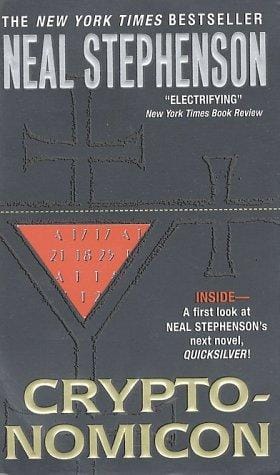Unlocking “Cryptonomicon”: A Deep Dive into Neal Stephenson’s Epic
Neal Stephenson’s “Cryptonomicon” blends WWII code-breaking with 1990s cyber-startup drama, exploring privacy, war, and technology in an ambitious 1,100-page techno-thriller.

Introduction: Why “Cryptonomicon” Still Matters
Published in 1999, Neal Stephenson’s “Cryptonomicon” has earned a reputation as one of the most ambitious techno-thrillers ever written. Blending World War II code-breaking adventures with 1990s cyber-startup fever, the novel offers a sweeping meditation on cryptography, information freedom, and the human stories buried beneath the algorithms. More than two decades later, it continues to captivate readers who crave intelligent fiction that unites history, mathematics, and speculative technology.
Plot in a Nutshell
The novel braids two primary timelines. The first follows mathematical prodigy Lawrence Pritchard Waterhouse, U.S. Marine Corporal Bobby Shaftoe, and an ensemble of Allied code-breakers fighting the Axis powers through the clandestine world of signals intelligence. The second timeline jumps to the late 1990s, where Waterhouse’s grandson, Randy, joins cryptographer Avi Halaby and hacker Amy Shaftoe to build a data-haven in Southeast Asia. Their startup, Epiphyte Corporation, hopes to create a digital sanctuary for private currency and secure communication.
Stephenson masterfully interleaves these strands so that discoveries made in 1942 resonate in 1997. Gold smuggled by the Japanese, secret Nazi bank accounts, and long-buried encryption keys move back and forth across the pages like chess pieces, propelling both timelines toward a shared climax.
High Stakes and Hidden Treasures
Whether dodging U-boats in the Atlantic or debugging server farms in Manila, the characters search for the same prize: freedom from surveillance and authoritarian control. The ultimate treasure may be a literal cache of wartime gold, yet its symbolic value lies in funding a future where data cannot be seized by governments at will.
Historical Backdrop and Real-World Cryptography
Stephenson’s meticulous research shines as he describes Turing machines, the German Enigma cipher, and the Allied code-breaking efforts at Bletchley Park. Real historical figures—Alan Turing, General MacArthur, Admiral Yamamoto—appear briefly, anchoring the fiction in authentic context. The author’s digressions into modular arithmetic, frequency analysis, and one-time pads read like lively pop-science essays embedded inside the narrative, making advanced technical concepts accessible without slowing the pace.
Major Themes
Information as Power
“Cryptonomicon” argues that control over information is the defining battle of any era. From Waterhouse’s handcrafted ciphers to Randy’s public-key infrastructure, each generation wrestles with how to keep secrets safe while sharing knowledge widely enough to innovate. The book’s prescient discussion of privacy foreshadows today’s debates on encryption backdoors, blockchain, and digital currencies.
War, Technology, and Morality
Beneath the clever puzzles lies a sober reflection on how technological advances shape—and are shaped by—violent conflict. Waterhouse’s algorithms help the Allies sink enemy ships, yet every victory raises ethical questions about collateral damage and the morality of secrecy. Stephenson refuses to paint purely heroic portraits; instead, he reveals how brilliant minds can be both saviors and accomplices.
Memorable Characters
The sprawling cast is one of the novel’s greatest pleasures. Waterhouse embodies the eccentric academic who speaks in differential equations; Shaftoe is the action-oriented Marine who navigates warfare with streetwise flair; Randy serves as the contemporary geek hero confronting venture capital headaches, romance, and network attacks in equal measure. Female characters like cryptanalyst Mary Catherine Waterhouse and salvage-diver Amy Shaftoe provide agency and technical skill, subverting the genre’s typical male dominance.
Style and Structure
At roughly 1,100 pages, “Cryptonomicon” could have collapsed under its own weight, yet Stephenson’s energetic prose, dark humor, and compulsive attention to detail keep the story aloft. Extended footnotes, fictional RFCs, and tongue-in-cheek mathematical proofs create a playful meta-text that invites readers to participate in the puzzle. The parallel timelines converge with clockwork precision, rewarding patient readers with “aha” moments when seemingly trivial anecdotes echo across decades.
Legacy and Influence
The novel arrived during the dot-com boom and helped cement Stephenson’s stature as an oracle of digital culture. Tech entrepreneurs have cited “Cryptonomicon” as inspiration for encrypted email services, Bitcoin precursors, and offshore data centers. Its vision of a borderless information economy anticipated many developments that now define the 21st-century internet—both the liberating possibilities and the accompanying threats.
Should You Read It?
If you’re interested in cryptography, WWII history, hacker lore, or simply crave a literary workout, “Cryptonomicon” delivers on every front. It demands attention and a tolerance for digressions, but the payoff is a multifaceted epic that entertains as it educates. For readers seeking a single novel that bridges the gap between historical fiction and speculative technology, Neal Stephenson’s masterpiece remains essential.



